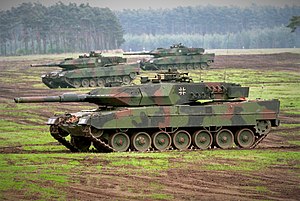Leopard 2
| Leopard 2 | |
|---|---|

Leopard 2A5 of the German Army (Heer)
|
|
| Type | Main battle tank |
| Place of origin | West Germany |
| Service history | |
| In service | 1979–present |
| Used by | See Operators |
| Wars |
War in Afghanistan Syrian Civil War |
| Production history | |
| Designer | Krauss-Maffei |
| Designed | 1970s |
| Manufacturer |
Krauss‐Maffei Wegmann Maschinenbau Kiel |
| Unit cost | 2A6: US$5.74 million (2007) |
| Produced | 1979–present |
| Number built | 3,480 |
| Variants | See Variants |
| Specifications | |
| Weight | 2A6: 62.3 tonnes (68.7 short tons) |
| Length | 2A6: 9.97 metres (393 inches) (gun forward) |
| Width | 2A6: 3.75 m (148 in) |
| Height | 2A6: 3.0 m (120 in) |
| Crew | 4 |
|
|
|
| Armour | 2A6: 3rd generation composite; including high-hardness steel, tungsten and plastic filler with ceramic component. |
|
Main
armament |
1× 120 mm Rheinmetall L55 smoothbore gun (42 rounds) |
|
Secondary
armament |
2× 7.62 mm MG3A1 (4,750 rounds) |
| Engine |
MTU MB 873 Ka-501 liquid-cooled V12 twin-turbo diesel engine 1,500 PS (1,479 hp, 1,103 kW) at 2,600 rpm |
| Power/weight | 24.1 PS/t (17.7 kW/t) |
| Transmission | Renk HSWL 354 |
| Suspension | Torsion bar suspension |
| Fuel capacity | 1,200 litres (264 imperial gallons; 317 US gallons) |
|
Operational
range |
550 km (340 mi) (internal fuel) |
| Speed | 72 km/h (45 mph) |
The Leopard 2 is a main battle tank developed by Krauss-Maffei in the 1970s for the West German Army. The tank first entered service in 1979 and succeeded the earlier Leopard 1 as the main battle tank of the German Army. Various versions have served in the armed forces of Germany and 12 other European countries, as well as several non-European nations. The Leopard 2 was used in Kosovo with the German Army and has also seen action in Afghanistan with the Danish and Canadian contributions to the International Security Assistance Force, as well as seeing action in Syria with the Turkish Armed Forces against IS and the YPJ.
There are two main development batches of the tank, the original models up to Leopard 2A4, which have vertically faced turret armour, and the "improved" batch, namely the Leopard 2A5 and newer versions, which have angled arrow-shaped turret appliqué armour together with other improvements. All models feature digital fire control systems with laser rangefinders, a fully stabilized main gun and coaxial machine gun, and advanced night vision and sighting equipment (first vehicles used a low-light level TV system or LLLTV; thermal imaging was introduced later on). The tank has the ability to engage moving targets while moving over rough terrain.
Even as the Leopard 1 was just entering service, the German military was interested in producing an improved tank in the next decade. This resulted in the start of the MBT-70 development in cooperation with the United States beginning in 1963. However already in 1967 it became questionable whether the MBT-70 would enter service at any time in the foreseeable future. Therefore, the German government issued the order to research future upgrade options of the Leopard 1 to the German company Porsche in 1967. This study was named vergoldeter Leopard (Gilded Leopard) and focused on incorporating advanced technology into the Leopard design. The projected upgrades added an autoloader, a coaxial and an independent commander's periscope. The anti-air machine gun could be operated from inside the vehicle and a TV surveillance camera was mounted on an expendable mast. The shape of the turret and hull was optimized using cast steel armour, while the suspension, transmission and the engine exhaust vents were improved.
...
Wikipedia
